Texas Railroad History - Tower 131 - Terrell
A Crossing of the Texas Midland Railroad and the Texas & Pacific Railway
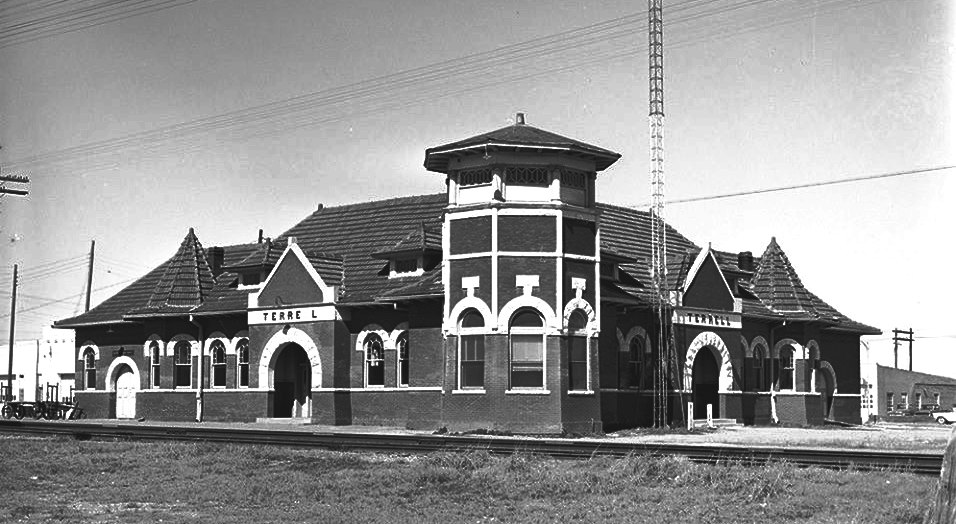 |
Left: DeGolyer Library at
Southern Methodist University provides this image of the Terrell Union
Depot taken February, 1961. The photographer, Everett L. DeGolyer, Jr.,
is on or near the former Texas Midland (TM) right-of-way immediately south of
where it crossed the Texas & Pacific (T&P) tracks visible in the
foreground. The interlocker installed as Tower 131 was controlled from
inside the depot, presumably in the near corner facing the crossing.
Three years before this photo was taken, Tower 131 was decommissioned when the Texas Midland tracks through Terrell were abandoned.
Below: This
photo of Terrell Union Depot comes from a 1908 vintage postcard.
Offset
printing presses became commercially available c.1905, leading to an explosion
of mass-produced, photo postcards retouched
or colorized by hand before being sent to the
presses. In
those days, the station was adorned with a "witches hat" roof above the
corner of the station. Whether it was due to a tornado or wind storm,
replacement of a leaky roof or perhaps simply a change in the
architectural preferences of the day, the date and reason for the
revised roofline has not been determined. |
In the postcard photo at
right, note the gate
lined against one of the two east / west T&P tracks in front of the station. There is a gate post visible left of
center,
presumably to line the gate against the Texas Midland. Though it could not be lined simultaneously
against both T&P tracks, its position would be observable by T&P
engineers on either track. Trains were allowed to approach a gated crossing at
restricted speed, i.e. slow enough that the engineer could come to a
full stop short of the diamond if he observed the gate lined against his
train. Trains here would be slowing anyway nearing the depot. The crossing was gated until January, 1927 when the Tower 131
electric interlocker was installed.
Below: undated (post-1905) colorized picture postcard of the
west side of Union Depot showing a westbound Texas & Pacific train
at the station
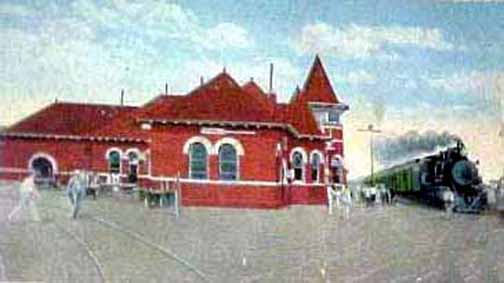 |
 |
The Texas & Pacific (T&P) Railway was chartered by
Congress in 1871 with instructions to build a transcontinental railroad from
Marshall, Texas to San Diego, California. Turning that command into reality
required financing, compliance with Texas' railroad laws, and solving an
assortment of complicated issues related to two predecessor railroads that had
mostly been destroyed by the Civil War.
The interplay of state and Federal charters, land grants given and revoked, and
a host of other financial and practical issues produces a complex history of the
founding of the T&P. Noted railroad historian S. G. Reed in A History
of the Texas Railroads (St. Clair Publishing, 1941) spends seven pages
just getting to the beginning of the
construction of two parallel lines and one connector
that comprised the early T&P. The parallel lines were the Northern Division
from Texarkana to Sherman and the
Southern Division from Marshall to
Dallas;
the connector ran from Texarkana through Jefferson
to Marshall. In August, 1873, Dallas celebrated the arrival of the first T&P
train from Marshall. The T&P would continue west, but would only build as far as
the new settlement of Sierra Blanca in west Texas from which it used Southern
Pacific (SP) tracks to reach El Paso, its final
western terminus.
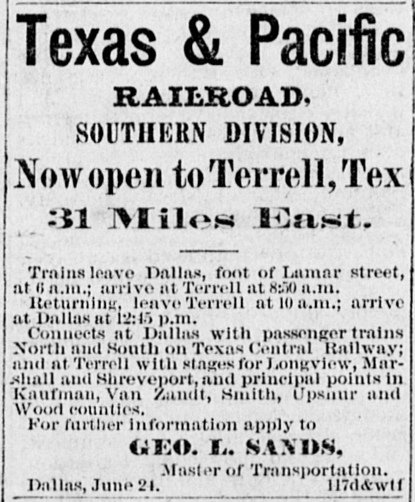 |
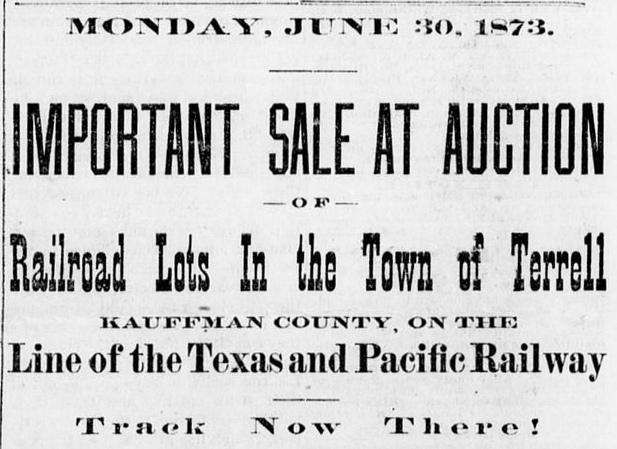 |
Far Left:
The westward construction of the southern division in 1873 had begun at
Longview; the T&P had acquired and rehabilitated existing tracks from Marshall. Soon thereafter, the T&P had also begun building east from
Dallas, and by the latter part of June, the new town of Terrell had been
founded. On Tuesday, June 24, 1873, a private excursion was held to show
off the current state of construction to local media and politicians.
That same day, this ad first appeared announcing train schedules between Dallas and
Terrell. The "Texas Central" reference is for the "Houston &
Texas Central" at Dallas, not the Texas Central that would
build through Terrell in 1882.
Left:
Setting a train schedule to Terrell was in preparation for a major town lot
auction planned there for Monday, June 30. (both items,
Dallas Weekly Herald, June 28,
1873) |
Terrell was named by the T&P for Robert A. Terrell, a farmer who
donated acreage to the railroad in exchange for a depot. The railroad would
need a water stop in this vicinity, and as the Clarksville Standard
of March 22, 1873 mentions, an artesian well was located near the depot at Terrell's
farm where "...the water rises within a few inches of the surface.",
always a good sign for steam railroads. A town lot sale was held on June 30,
1873 to jumpstart the settlement. The completion of the T&P rail line through Terrell gave citizens
access to St. Louis and the Midwest via Texarkana, and to
Houston and Galveston
via connection in downtown Dallas with the Houston
& Texas Central (H&TC) Railroad. Terrell was not the county seat, but it grew
at a steady pace with much of its commerce driven by cotton farming. Some area farmers began growing wheat instead of cotton
because it was easier to cultivate and harvest. The railroad provided access to
larger markets at Dallas and Shreveport, adding to the economy. By 1882,
Terrell residents could catch a T&P train at the local depot and travel
to
El Paso with connections to Los Angeles.
The second railroad through Terrell arrived in 1882 when the Texas Central (TC) Railroad built the initial 38 miles of its
"northeast branch" from Garrett to Terrell. Garrett was a junction a few miles
north of Ennis on the main line of the H&TC
which ran between Houston
and Denison. The TC had been chartered in 1879 by
H&TC's owners/investors as they sought to isolate the financial impact of building two major
H&TC branch lines. The other was the TC's "northwest branch", which actually began at
Bremond on the H&TC main line but the first 55 miles through
Waco to Ross were owned by an H&TC subsidiary, the Waco & Northwestern (W&NW). Ostensibly heading for the Texas Panhandle, the TC
had extended the northwest branch 178 miles from Ross to Albany in 1879-1881,
crossing the Brazos River, a major undertaking, near
Morgan. No further construction was done on the northwest
branch, but the northeast branch was
extended fourteen miles north from Terrell to Roberts, remaining nineteen
miles shy of Greenville. This was likely when the
TM tracks first crossed over the T&P near downtown Terrell, but when did it
happen? The generally accepted source says 1884, but newspapers indicate an earlier date.
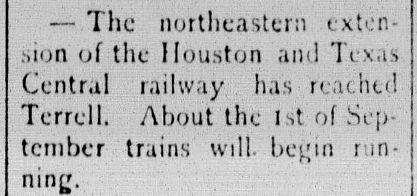 |
Left: The Brenham
Daily Banner of August 19, 1882 reported the tracks reaching
Terrell, imprecisely using "Houston and Texas Central" instead
of "Texas Central". The legal separation was for convenience, the ownership was virtually the same,
and it arguably was a "northeastern
extension of the Houston and Texas Central Railway". This date sets a
floor for how early the tracks were laid to Roberts. Notably, Roberts was on land purchased
by the TC on October 26, 1882 from Governor
Oran M. Roberts (who would leave office three months later.) A 1981 book by Charles Zlatkovich asserts 1884 as the
year the extension was built, and this timeframe has been echoed in
other histories... |

...but...Above: The
Galveston Daily News of November
11, 1882 reported construction trains operating to Roberts, which suggests
completion by early 1883. Quinlan, named for a Texas Midland Director, was later established as a new town
1.5 miles north of Roberts...which faded away. |
The Railroad Commission of Texas (RCT) did not exist until 1891. At the
outset, it began requiring railroads to submit annual construction reports, and
it attempted to go back to the beginning of railroad development in Texas to
build a collection of such records. In so doing, it assigned 1884 as the year of construction
from Terrell to Roberts, fourteen miles, as reported by Charles Zlatkovich in
his book Texas Railroads: A Record of Construction and
Abandonment (University of Texas, 1981.) The fact that construction trains could be observed departing northbound from
Terrell in November, 1882 (which is certainly consistent with a late October
land purchase) would lend credence to whatever source the Galveston
Daily News used for its report. An article in the
Greenville Banner of March 21, 1883 quoted by
the Galveston Daily News of March 25 states
explicitly that "Roberts is the present terminus of the northeast branch of
the Houston & Texas Central railroad." The extension to Roberts
appears to have been in
place by early 1883 at the latest.
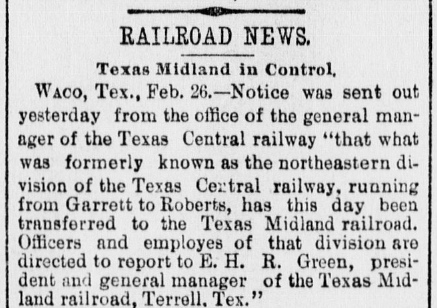 |
The
Depression of 1882-1885 hit railroads particularly hard, resulting
in the H&TC entering receivership in February, 1885. This was
followed quickly by receivership for the TC on April 4th. In April, 1890, the H&TC
was reorganized and sold back to SP (which had acquired it in 1883), but the W&NW branch
(Bremond to Ross) was not part of the sale. A year later, the TC was sold to a committee of bondholders who chartered a new TC to
operate the northwest branch. Wealthy Wall St. investor Hetty
Green, a major bondholder of both TC and H&TC bonds, negotiated to
relinquish her substantial interest in the northwest
branch in exchange for title to the northeast branch. She sent her son, Edward H. R. "Ned" Green, to
manage her interests. He arrived in Terrell in early 1892 and chartered
the Texas Midland (TM) Railroad to operate and extend the northeast
branch. Due to the complexity of the transaction and the approval
required by the Bankruptcy Court, the title transfer did not occur until
1893. Meanwhile, Green plotted to win the auction for the W&NW which was
to be put up for sale on the courthouse steps in
Waco in late 1892. Green won it with a high bid of $1.365 million, planning to consolidate
the TM and the W&NW into a new Texas railroad. Unfortunately for
Green, the terms of the sale were
challenged successfully in court and the auction was set aside. After a
lengthy court battle, Green gave up and did not participate in the
subsequent W&NW auction, which was won by SP.
Left: The northeast
branch of the Texas Central became officially owned by the Texas Midland
on February 25, 1893, as announced by the
Galveston Daily News of February
28, 1893. |
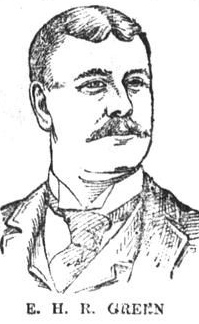 |
Left: A profile of E. H. R. Green in the
El Paso International Daily Times
of May 30, 1891 (nearly a year before Green arrived in Texas) described
him as a savvy businessman who had already amassed a personal net worth
of $10 million despite being only 24 years old. Green lived in Terrell
where his railroad was headquartered. He became notorious for bringing
the first automobile to Texas, which he drove to Dallas periodically to
visit his girlfriend (she could not live in Terrell due to her unsavory
past.) Green carried his large frame (6'4", ~ 275 lbs.) on an artificial
leg resulting from a serious accident in 1887. True or not, the story is
that his wealthy but famously tight-fisted mother tried to get him
treated for free at a charity hospital in New York. Discovering she
would have to pay, she asked the price to have the leg treated. $450.
What was the price to have it amputated? $50.
Perhaps Green's
most significant undertaking was his concern that
Texas' cotton crop was doomed unless the boll weevil could be
eradicated. Hauling cotton was the lifeblood of his railroad, so Green financially supported experimental cotton farms near
Terrell to test cotton hybrids and new methods of cultivation.
This ultimately led to success in the fight against the boll weevil and
became the impetus for the establishment of the
County Extension Service
across Texas managed through Texas A&M University. When the
experiments were concluded, Green demonstrated his business savvy by
converting one farm into a flower nursery. He was soon selling $100,000
in flowers each year.
Right: Although Green
never served on the Governor's security detail, he
was awarded the honorary title of Colonel by his friend, Texas Governor
Oscar Colquitt, having actively supported Colquitt for the 1910
election. Apparently, however, Green had been known as Colonel, at least
around Terrell, from as soon as he arrived nearly twenty years earlier, as evidenced by a story in the Forney Tribune
of September 21, 1892 quoting the Terrell
Times. |
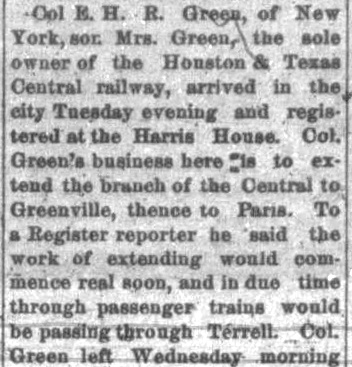
Forney Tribune, September 21, 1892 |

Left: The Railway
Journal of April, 1901 reported that an experimental laboratory was
being built by Green at Terrell for the development of railroad devices of his
own design. Whether anything valuable was ever produced by the lab is
undetermined.
Under Green's leadership, the TM
immediately established a connection with the H&TC at Ennis, site of
a major SP station, rather than Garrett which was simply a railroad
junction. This
involved building four miles south from TM's
existing line, the connecting point being two miles east of Garrett (at
32 22 44, -96 37 42; the leftover two miles of track into Garrett was
abandoned in 1907.) Green followed up by building nineteen miles of
track from Roberts to Greenville; the first train arrived in
Greenville on August 25, 1894. The town was already served by the St. Louis Southwestern ("Cotton
Belt") and Missouri, Kansas & Texas ("Katy") railroads,
which would be potential interchange partners for traffic destined to
Houston / Galveston via Ennis, bypassing congestion in Dallas.
Green was only 27 years old and he began relying on the advice of B. F.
Yoakum, a 36-year old rising star among Texas railroad executives who
was in the process of becoming the General Manager of the St. Louis - San Francisco ("Frisco")
Railway, a major Midwest railroad. Yoakum advised Green to build to
Paris, so Green procured rights to use the
Cotton Belt tracks between Greenville and Commerce. From Commerce, Green built 37 miles
north to Paris, arriving in 1896. Yoakum's advice proved both prescient
and self-serving; the TM's tracks provided an efficient connection
between the Frisco at Paris and the H&TC at Ennis for traffic to south
Texas. Soon, the Frisco, the H&TC and the TM combined to run first class
Lone Star Limited passenger service between St. Louis and Houston, with the Ennis - Paris
segment operated by the TM.
Right:
In November, 1921, the TM dropped its rights on the Cotton Belt and
began operating on its own 14-mile line between Greenville and Commerce.
The impetus for this track segment is undetermined, but Green
had been pondering it for many years. TM accounting records report a
preliminary survey (valued at $444.25!) had been completed prior to
1914. The new line was no shorter since it paralleled the Cotton Belt
for the entire distance, thus the cost of trackage rights and/or
congestion delays was presumably the principal motivation. Parallel
lines of this nature were generally frowned upon by RCT, but this
segment was encompassed within the route approved in TM's charter, hence
no additional authority was needed. This newspaper article goes on to
list a new "time card" for the four daily trains through Cooper (between Commerce and Paris) but does not state whether the schedule
change was a direct result of the new track. (Cooper
Review, November 18, 1921)
Starting around 1910, Ned Green began
spending much of his time in New York helping his mother with her complex
business affairs and assisting in managing her estate. She was 76 years old at
the time, and she died in 1916 at age 81. Ned Green inherited half of his
mother's estate (the other half went to his sister), and he was finally able to
marry his longtime girlfriend who was still living in Dallas (his mother opposed
the marriage, hence Green waited, lest he jeopardize his massive inheritance.)
Green continued to own and operate the Texas Midland until 1928 when he sold it
to SP. |
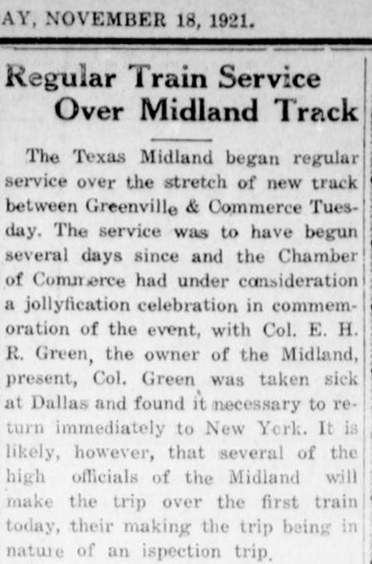 |
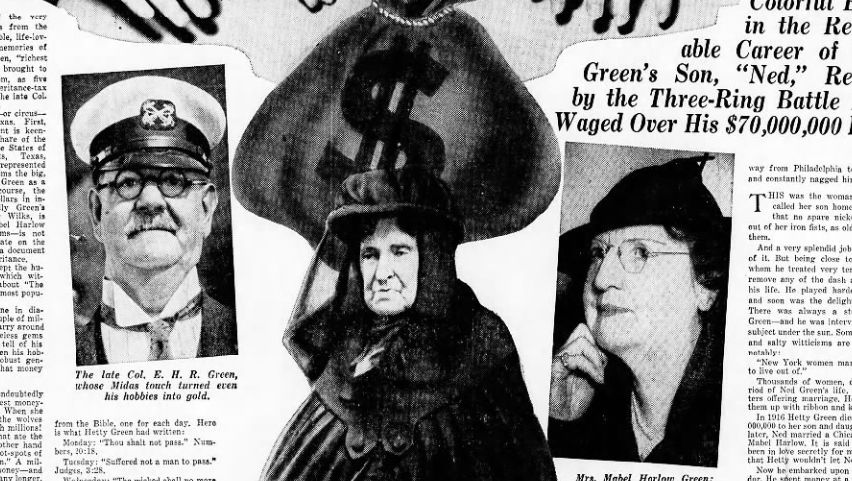 Left:
San Bernardino County Sun, November
14, 1937
Left:
San Bernardino County Sun, November
14, 1937
Many newspapers carried stories about the drama over the
resolution of Col. Green's estate. Upon his death at Lake Placid, New York in
1936, six governments and two individuals squared off in court. The two
individuals were his wife, Mabel Green (right side of the image), and his
sister, Mrs. Matthew Wilks, both wanting to inherit the bulk of the estate. The
Federal government and the states of New York, Vermont, Massachusetts, Florida
and Texas were fighting over taxes on the inheritance based on residency claims.
Green's estate was large from his own endeavors, but it became immense when
he inherited half of the estate of his mother, Hetty (center of the
image.) It had reached an estimated $70 million by the time of his death (worth
$1.55 billion in 2023 dollars.) Mabel had signed a prenuptial agreement at the
time of their marriage, hence her claim was
limited unless Texas (which did not recognize such agreements) won the lawsuit.
She eventually settled for $500,000.
The six governments
fought over inheritance taxes in a Texas courtroom, but eventually ended up before the U. S. Supreme Court. The Court appointed a
Special Master to hear the evidence in The State
of Texas v. Florida, et. al. In 1939, Massachusetts was declared the winner.
|
Right:
These disconnected excerpts are taken from a lengthy article about the
Texas Midland in the June 1, 1895 issue of the
Greenville Banner. Green had
been on the job only a couple of years and had little practical knowhow
in railroading, yet he brought numerous innovations to Texas, starting with two beds built north
of Kaufman in which to produce burnt ballast. Its hardness and water absorption
properties improved the roadbeds through the "black gumbo" soil in east Texas for faster and smoother passenger travel. Green
was the first in Texas to employ dynamos on the smoke stacks of locomotives to produce electrical power for the train's headlights and
to light its passenger cars. To improve freight handling and
reliability, Green began using steel boxcars rather than wooden ones. |
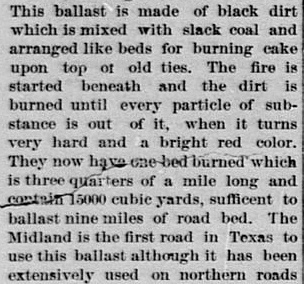 |
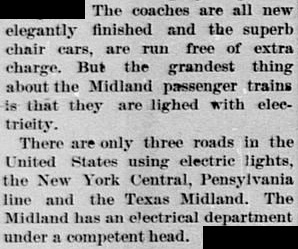 |
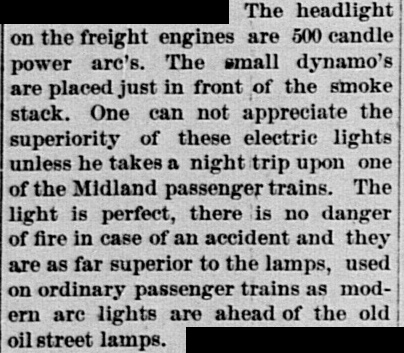 |
The Frisco connection at Paris and the H&TC connection at Ennis combined to
provide the TM
with reliable
passenger traffic between the Midwest and south Texas. With the T&P operating
substantial passenger business on their east/west line, it made sense to
construct a union station in Terrell to serve both railroads (RCT had the power
to order railroads to build union depots; it eventually
would have done so for Terrell.) Terrell Union Depot opened in the northwest quadrant of
the diamond in 1901. That same year, RCT was given state law authority to
regulate safety where two or more railroads crossed at grade (RCT also had
jurisdiction over grade-separated crossings but found little need for
regulations.) RCT immediately mandated swing gates at all such grade
crossings and it began to issue orders to install interlockers at specific
crossings that it deemed high priority. The crossing at Terrell was not one of
them because trains were not approaching the diamond at track speed. The Union
Depot and the freight depots for both railroads were located near the diamond,
hence all trains were
slowing anyway as they approached the crossing and most were stopping at one of
the depots.
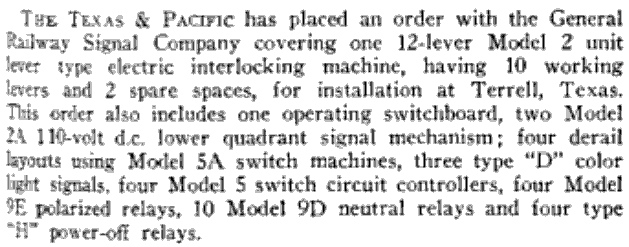 |
State law required all trains to stop completely before crossing another
railroad's track at grade. While this was the ultimate safety solution,
it was wasteful of time and fuel. The purpose of the 1901 law was to regulate safety
while also improving the economics of railroading by reducing delays
and fuel consumption that resulted when a train was forced to stop unnecessarily. Mechanical
interlocking plants had been developed to work with signal systems and derail
devices to require
trains to stop at crossings only when actually necessary to preclude collision. As the range of
locomotives increased, the frequency of trains having no need to stop at
Terrell also increased, hence the crossing was interlocked
on January 19, 1927 when Tower 131 was commissioned by RCT. It was a 13-function electric interlocking plant
with
the switchboard located inside Union Depot. On September 7, 1942, the Interstate
Commerce Commission (ICC) granted T&P's request to decommission the
derails at Tower 131.
Left:
Railway Age, August 7, 1926. |
|
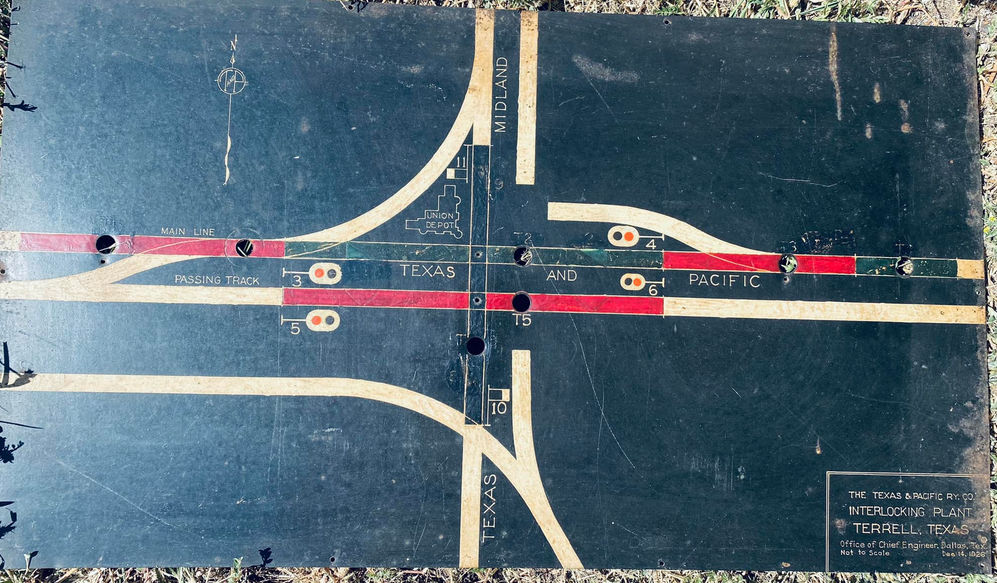
Left: This track board for
Tower 131 was discovered by Myron Malone during a visit to the Cotton Belt Depot
Museum in Tyler. It was among an assortment of items in a storage area awaiting
opportunity for display at the museum. Magnification of the lower right
corner appears to reveal a date of December 14, 1926, about one month prior to
the interlocker becoming operational.
The diagram shows four signals on
the T&P tracks numbered 3 through 6, and two switches on the TM tracks numbered
10 and 11. The numeral 8 is detectable under magnification across from the 10
switch, and 9 appears across from the 11 switch. These numbers presumably
correspond to interlocker control buttons on the switchboard (it was an electric
interlocker, hence there were no levers for manual operation.) 'T2' and 'T5' labels appear beside the
holes in the T&P tracks immediately east of the diamonds. The holes, of which
there are seven total, presumably held light bulbs used as status indicators for
specific
interlocker functions.
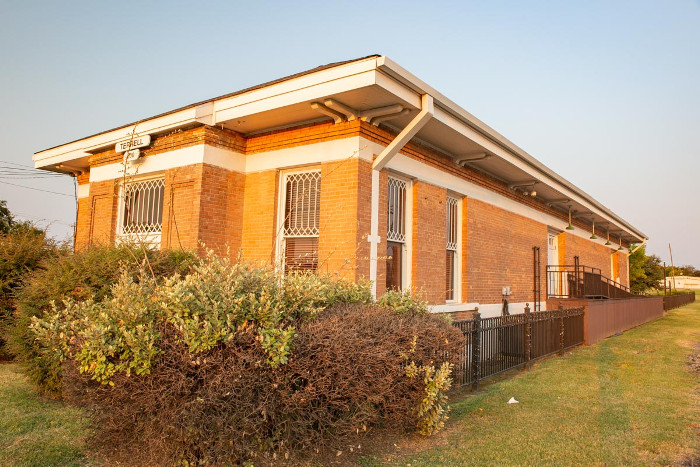
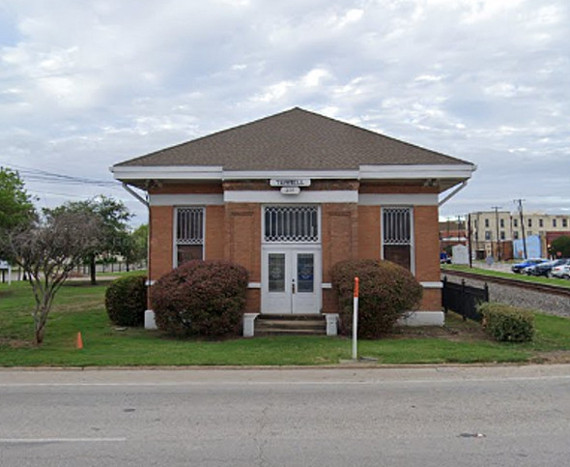
Above Left: This brick T&P
freight depot was erected in 1911. The view is of the northeast corner; the T&P main line
tracks were north of the depot to the right, and one track owned by Union Pacific remains
operational. According to the 1928 Sanborn Fire Insurance map of Terrell, the TM had spur tracks on the south side of the
T&P depot that led to
businesses and a "coal and wood yard" farther west. The depot closed
in 1977 and has been preserved, although its current use is undetermined. There
is a paved parking lot on the west side. (Wikimedia Commons photo).
Above Right: This view of the east side of the T&P freight depot
is taken from S. Virginia St. Before the rerouting of Hwy 34, S. Virginia
carried the highway with a grade crossing at the T&P track to the right. (Google Street View, October 2023)
Below: These two recent
views of the abandoned TM freight depot in Terrell show that it now sits in the shadows of
the Hwy 34 overpass which is immediately east of the building, occupying the
former TM right-of-way. This depot was also used as a passenger facility for the Texas
Interurban Railway which began serving Terrell on January 14, 1923. Entering
Terrell from the west, the interurban line was south of the T&P tracks and
remained so all the way to the TM depot. Using Union Depot as the Interurban
station would have required crossing at grade to the north side of the T&P
tracks. The 1921 Sanborn map of
Terrell labels this building "T. M. R. R. Offices & Freight Ho." The 1928 map
changes it to "Interurban Station" even though it was still in use as a railroad
freight depot. By the time of the 1949 update to the Sanborn Map, it had been
relabeled "Magnolia Petroleum Co.", predecessor to Mobil Oil, even though the TM
tracks through Terrell were still operational until 1958. As recently as the
early 2000s, signs from decommissioned Mobil gas stations were being stored
outside of the building. (photos courtesy waymarking.com)
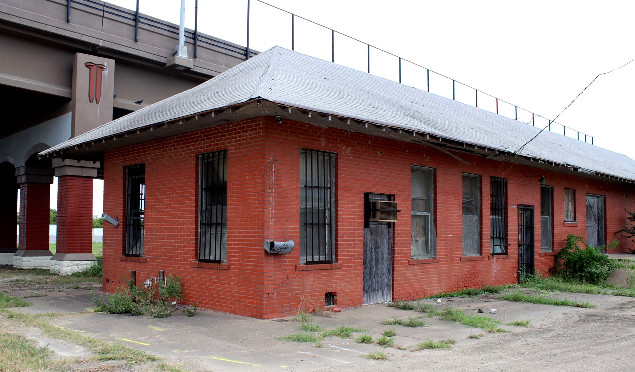
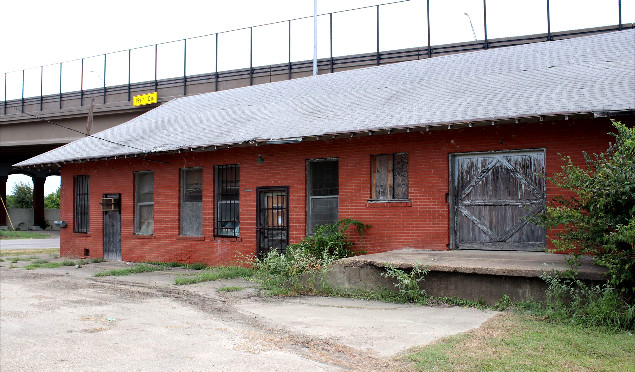

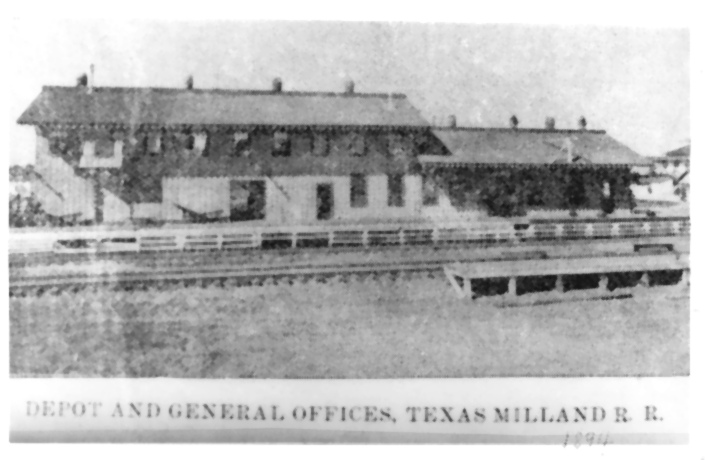
Above Left: The 1897 Sanborn
Fire Insurance map of Terrell shows that prior to the construction of Union
Depot, TM's combination passenger and freight depot was located trackside at
Grove St., the same location at which the brick TM freight depot resides today.
The '2' and '1' marks within the building's outline indicate that the depot was
split, with a longer 2-story section assigned to freight and offices, and a
shorter 1-story section assigned to passenger service. The map depicts a large
platform on the west side of the depot. Since the streets were not paved, this
provided a means for passengers to arrive and depart without immediately
traipsing through the mud often present from frequent east Texas rains. Above Right: This photo (hat
tip Chino Chapa) from the library of Texas A&M University - Commerce faces
the east side of the depot, showing the
freight/passenger split. The larger Sanborn map suggests that the structure partly visible in the
background along the right edge of the image is the 2-story Central Hotel a
block north and west of the depot.
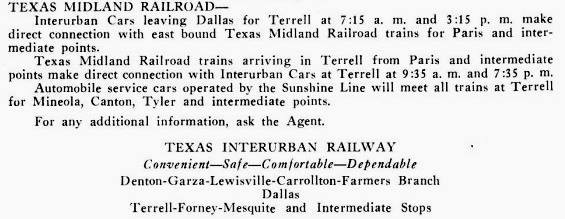 Although
the 1928 Sanborn Fire Insurance map of Terrell labeled the TM freight depot as
"Interurban Station", the map does not show interurban tracks anywhere in
Terrell. This is unusual because the tracks had been in place for five years by
then and interurban tracks regularly appear on Sanborn maps of other towns.
While the precise route through Terrell remains subject to further
research, it is well-established that the interurban remained south of the T&P
tracks through town and that the Texas Midland freight depot served as
the passenger station.
Although
the 1928 Sanborn Fire Insurance map of Terrell labeled the TM freight depot as
"Interurban Station", the map does not show interurban tracks anywhere in
Terrell. This is unusual because the tracks had been in place for five years by
then and interurban tracks regularly appear on Sanborn maps of other towns.
While the precise route through Terrell remains subject to further
research, it is well-established that the interurban remained south of the T&P
tracks through town and that the Texas Midland freight depot served as
the passenger station.
Left:
This excerpt from a larger 1925 advertisement for the Texas Interurban Railway
explains the service to and from Paris and intermediate points that
the Texas Midland offered for Interurban passengers at Terrell. The ad
generically uses "at Terrell", "in Terrell" and "direct connection", finessing
the question of whether connecting passengers had to walk ~ 250 yards of city
streets between the TM freight depot
and Union Depot to transfer. (Portal to Texas History, University of North
Texas)
In 1928, about a year after the Tower 131 interlocker was installed, Green sold his
railroad to SP, which merged it into the Texas & New Orleans (T&NO) Railroad.
T&NO had been selected to become SP's primary operating entity for all of its Texas and Louisiana
railroads, a merger process that
was completed in 1934. The merger did not include the Cotton Belt of which SP
had gained control
in 1933. SP promptly abandoned the TM line between
Greenville and Commerce in favor of the Cotton Belt tracks (which the TM had used
until 1921.) Much of Texas Highway 224 sits atop the abandoned TM right-of-way
(the Cotton Belt tracks are still intact, owned by the Northeast Texas Rural
Rail Transportation District.) The remainder of the TM
line was abandoned in phases beginning with the tracks from Ennis to Kaufman in
1942, followed by the segment from Kaufman to Greenville in 1958. The former TM
tracks between Commerce and Paris survived until abandonment by SP in 1975.
Since the early 1930s, Missouri Pacific (MP) had owned a controlling
interest in T&P stock, but had never exercised operational control. For
decades, the two
railroads had worked closely and cooperatively, and in 1976, MP fully merged
it, retiring the T&P's operational name. MP was acquired by Union
Pacific (UP) in 1982 and the MP name was dropped operationally in 1997. UP's
route through Terrell continues to see extensive traffic.
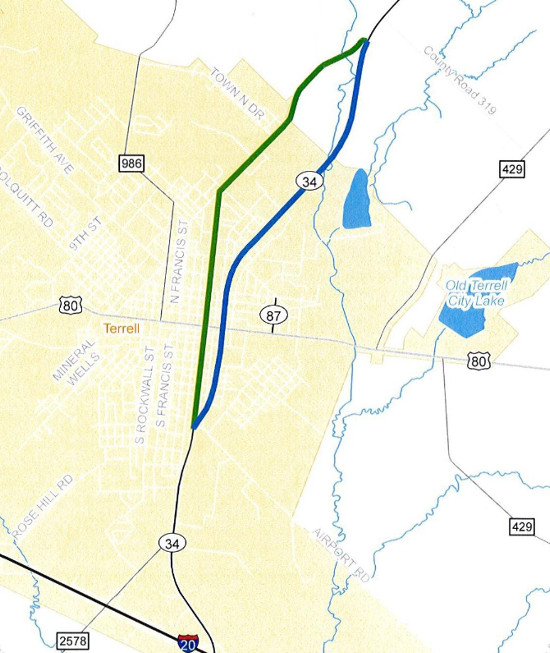
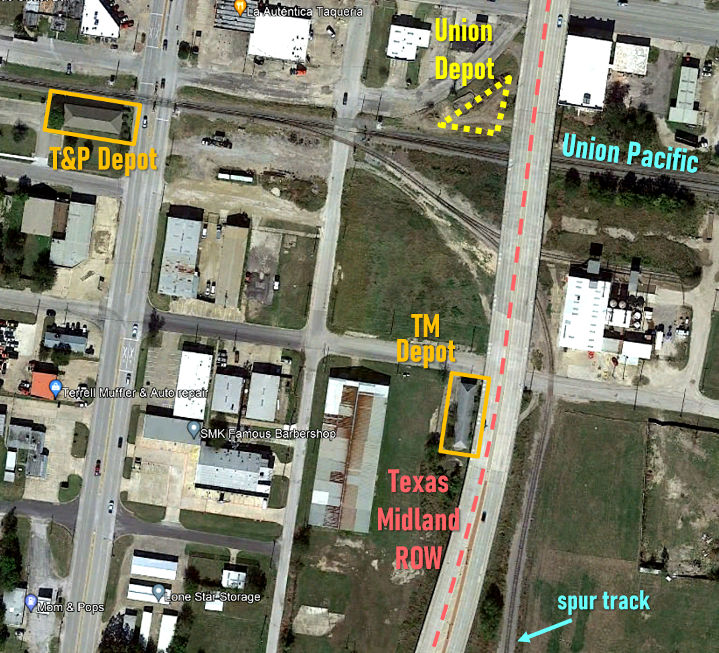
Above Left: The precise date
when Texas Highway 34 was built between Terrell and Greenville is undetermined,
but several sections of the highway were located east of and directly beside the
TM tracks (which may have been owned by T&NO by the time the highway was built.)
These sections were mostly north of its intersection with County Road 319 (2.5
miles north of Terrell.) Subsequently rebuilt and widened, the highway now sits atop the TM
right-of-way in several places en route to Greenville. In 2012, Highway 34 was re-routed
in Terrell to follow the TM right-of-way (blue) from the Airport Rd.
intersection to where it rejoined the original highway (green) near the County
Road 319 intersection. This map is taken from the minutes of a Texas Dept. of
Transportation meeting held February 28, 2013 at which the re-designation of the
new roadway officially as Texas Highway 34 was approved. The map does not mark
UP's line through Terrell, generally a block south of U.S. Hwy 80.
Above Right: This annotated
Google Maps satellite image shows a portion of the 0.4 miles of new
Highway 34 roadway that is elevated over UP's tracks, placing the TM depot and the
site of Union Depot in the shadow of the bridge. UP operates an industrial spur
to the south to serve a polyurethane foam manufacturer, traversing land that was
formerly occupied by TM yards and maintenance shops. Sanborn Maps show that TM
had a turntable and roundhouse in this area. It was approximately 300 yds. south
of the depot on the east side of the main track, about where an extension of
Newton St. would intersect the tracks. Historic aerial imagery from 1956 shows
that it had been dismantled by then, leaving no trace.
Below: In 1975, this railcar was
acquired by the Terrell Heritage Society from a private owner and
relocated to a city park. It was reportedly built by Pullman in 1890 and appears
to have been transferred to TM ownership when the TC northeast branch was
acquired. Early on, there was speculation (but apparently no conclusive
evidence) that it had at one time been Col. Green's private railcar. When the T&NO acquired
it as part of the 1928 TM acquisition, it was converted to quarters for
maintenance-of-way employees working between Ennis
and Paris. (Google Street View, December 2022)

























 Although
the 1928 Sanborn Fire Insurance map of Terrell labeled the TM freight depot as
"Interurban Station", the map does not show interurban tracks anywhere in
Terrell. This is unusual because the tracks had been in place for five years by
then and interurban tracks regularly appear on Sanborn maps of other towns.
While the precise route through Terrell remains subject to further
research, it is well-established that the interurban remained south of the T&P
tracks through town and that the Texas Midland freight depot served as
the passenger station.
Although
the 1928 Sanborn Fire Insurance map of Terrell labeled the TM freight depot as
"Interurban Station", the map does not show interurban tracks anywhere in
Terrell. This is unusual because the tracks had been in place for five years by
then and interurban tracks regularly appear on Sanborn maps of other towns.
While the precise route through Terrell remains subject to further
research, it is well-established that the interurban remained south of the T&P
tracks through town and that the Texas Midland freight depot served as
the passenger station.

